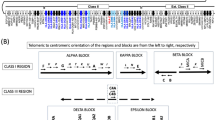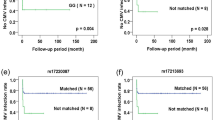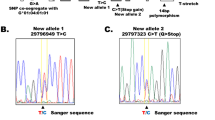Abstract
The HLA-G gene is predominantly expressed at the maternal–fetal interface. It has been associated with maternal–fetal tolerance and in the inhibition of cytotoxic T lymphocyte and natural killer cytolytic functions. At least two variations in the 3′untranslated region (UTR) of HLA-G locus are associated with HLA-G expression levels, the 14-bp deletion/insertion polymorphism and the +3142 single-nucleotide polymorphism (SNP). However, this region has not been completely characterized yet. The variability of the 3′UTR of HLA-G gene and its haplotype structure were characterized in 155 individuals from Brazil, as well as HLA-G alleles associated with each of the 3′UTR haplotype. The following eight variation sites were detected: the 14-bp polymorphism and SNPs at the positions +3003T/C, +3010C/G, +3027A/C, +3035C/T, +3142G/C, +3187A/G and +3196C/G. Similarly, 11 different 3′UTR haplotypes were identified and several HLA-G alleles presented only one 3′UTR haplotype. In addition, a high linkage disequilibrium among the variation sites was detected, especially among the 14-bp insertion and the alleles +3142G and +3187A, all previously associated with low mRNA availability, demonstrating that their effects are not independent. The detailed analyses of 3′UTR of the HLA-G locus may shed some light into mechanisms underlying the regulation of HLA-G expression.
This is a preview of subscription content, access via your institution
Access options
Subscribe to this journal
Receive 6 digital issues and online access to articles
$119.00 per year
only $19.83 per issue
Buy this article
- Purchase on Springer Link
- Instant access to full article PDF
Prices may be subject to local taxes which are calculated during checkout

Similar content being viewed by others
References
Klein J, Sato A . The HLA system. Second of two parts. N Engl J Med 2000; 343: 782–786.
Klein J, Sato A . The HLA system. First of two parts. N Engl J Med 2000; 343: 702–709.
Solier C, Mallet V, Lenfant F, Bertrand A, Huchenq A, Le Bouteiller P . HLA-G unique promoter region: functional implications. Immunogenetics 2001; 53: 617–625.
Carosella ED, Moreau P, Lemaoult J, Rouas-Freiss N . HLA-G: from biology to clinical benefits. Trends Immunol 2008; 29: 125–132.
Hviid TV . HLA-G in human reproduction: aspects of genetics, function and pregnancy complications. Hum Reprod Update 2006; 12: 209–232.
LeMaoult J, Krawice-Radanne I, Dausset J, Carosella ED . HLA-G1-expressing antigen-presenting cells induce immunosuppressive CD4+ T cells. Proc Natl Acad Sci USA 2004; 101: 7064–7069.
Ristich V, Liang S, Zhang W, Wu J, Horuzsko A . Tolerization of dendritic cells by HLA-G. Eur J Immunol 2005; 35: 1133–1142.
Colonna M, Navarro F, Bellon T, Llano M, Garcia P, Samaridis J et al. A common inhibitory receptor for major histocompatibility complex class I molecules on human lymphoid and myelomonocytic cells. J Exp Med 1997; 186: 1809–1818.
Colonna M, Samaridis J, Cella M, Angman L, Allen RL, O′Callaghan CA et al. Human myelomonocytic cells express an inhibitory receptor for classical and nonclassical MHC class I molecules. J Immunol 1998; 160: 3096–3100.
Allan DS, Colonna M, Lanier LL, Churakova TD, Abrams JS, Ellis SA et al. Tetrameric complexes of human histocompatibility leukocyte antigen (HLA)-G bind to peripheral blood myelomonocytic cells. J Exp Med 1999; 189: 1149–1156.
Rajagopalan S, Long EO . A human histocompatibility leukocyte antigen (HLA)-G-specific receptor expressed on all natural killer cells. J Exp Med 1999; 189: 1093–1100.
Cosman D, Fanger N, Borges L, Kubin M, Chin W, Peterson L et al. A novel immunoglobulin superfamily receptor for cellular and viral MHC class I molecules. Immunity 1997; 7: 273–282.
Ibrahim EC, Guerra N, Lacombe MJ, Angevin E, Chouaib S, Carosella ED et al. Tumor-specific up-regulation of the nonclassical class I HLA-G antigen expression in renal carcinoma. Cancer Res 2001; 61: 6838–6845.
Bukur J, Rebmann V, Grosse-Wilde H, Luboldt H, Ruebben H, Drexler I et al. Functional role of human leukocyte antigen-G up-regulation in renal cell carcinoma. Cancer Res 2003; 63: 4107–4111.
Rebmann V, Regel J, Stolke D, Grosse-Wilde H . Secretion of sHLA-G molecules in malignancies. Semin Cancer Biol 2003; 13: 371–377.
Sala FG, Del Moral PM, Pizzato N, Legrand-Abravanel F, Le Bouteiller P, Lenfant F . The HLA-G*0105N null allele induces cell surface expression of HLA-E molecule and promotes CD94/NKG2A-mediated recognition in JAR choriocarcinoma cell line. Immunogenetics 2004; 56: 617–624.
McIntire RH, Hunt JS . Antigen presenting cells and HLA-G—a review. Placenta 2005; 26 (Suppl): S104–S109.
Carosella ED, Horuzsko A . HLA-G and cancer. Semin Cancer Biol 2007; 17: 411–412.
Carosella ED, Favier B, Rouas-Freiss N, Moreau P, Lemaoult J . Beyond the increasing complexity of the immunomodulatory HLA-G molecule. Blood 2008; 111: 4862–4870.
Bukur J, Malenica B, Huber C, Seliger B . Altered expression of nonclassical HLA class Ib antigens in human renal cell carcinoma and its association with impaired immune response. Hum Immunol 2003; 64: 1081–1092.
Ibrahim el C, Allory Y, Commo F, Gattegno B, Callard P, Paul P . Altered pattern of major histocompatibility complex expression in renal carcinoma: tumor-specific expression of the nonclassical human leukocyte antigen-G molecule is restricted to clear cell carcinoma while up-regulation of other major histocompatibility complex antigens is primarily distributed in all subtypes of renal carcinoma. Am J Pathol 2003; 162: 501–508.
Castelli EC, Mendes-Junior CT, Donadi EA . HLA-G alleles and HLA-G 14 bp polymorphisms in a Brazilian population. Tissue Antigens 2007; 70: 62–68.
Parra FC, Amado RC, Lambertucci JR, Rocha J, Antunes CM, Pena SD . Color and genomic ancestry in Brazilians. Proc Natl Acad Sci USA 2003; 100: 177–182.
Castelli EC, Mendes-Junior CT, Viana de Camargo JL, Donadi EA . HLA-G polymorphism and transitional cell carcinoma of the bladder in a Brazilian population. Tissue Antigens 2008; 72: 149–157.
Castelli EC, Mendes-Junior CT, Wiezel CE, Peres NT, Simoes AL, Rossi NM et al. A novel HLA-G allele, HLA-G*010111, in the Brazilian population. Tissue Antigens 2007; 70: 349–350.
Tan Z, Shon AM, Ober C . Evidence of balancing selection at the HLA-G promoter region. Hum Mol Genet 2005; 14: 3619–3628.
Hiby SE, King A, Sharkey A, Loke YW . Molecular studies of trophoblast HLA-G: polymorphism, isoforms, imprinting and expression in preimplantation embryo. Tissue Antigens 1999; 53: 1–13.
O′Brien M, McCarthy T, Jenkins D, Paul P, Dausset J, Carosella ED et al. Altered HLA-G transcription in pre-eclampsia is associated with allele specific inheritance: possible role of the HLA-G gene in susceptibility to the disease. Cell Mol Life Sci 2001; 58: 1943–1949.
Hviid TV, Hylenius S, Rorbye C, Nielsen LG . HLA-G allelic variants are associated with differences in the HLA-G mRNA isoform profile and HLA-G mRNA levels. Immunogenetics 2003; 55: 63–79.
Rousseau P, Le Discorde M, Mouillot G, Marcou C, Carosella ED, Moreau P . The 14 bp deletion-insertion polymorphism in the 3′ UT region of the HLA-G gene influences HLA-G mRNA stability. Hum Immunol 2003; 64: 1005–1010.
Tan Z, Randall G, Fan J, Camoretti-Mercado B, Brockman-Schneider R, Pan L et al. Allele-specific targeting of microRNAs to HLA-G and risk of asthma. Am J Hum Genet 2007; 81: 829–834.
Veit TD, Chies JA . Tolerance versus immune response—microRNAs as important elements in the regulation of the HLA-G gene expression. Transpl Immunol 2009; 20: 229–231.
Rizzo R, Hviid TV, Govoni M, Padovan M, Rubini M, Melchiorri L et al. HLA-G genotype and HLA-G expression in systemic lupus erythematosus: HLA-G as a putative susceptibility gene in systemic lupus erythematosus. Tissue Antigens 2008; 71: 520–529.
Sipak-Szmigiel O, Cybulski C, Lubinski J, Ronin-Walknowska E . HLA-G polymorphism in a Polish population and reproductive failure. Tissue Antigens 2008; 71: 67–71.
Crispim JC, Mendes-Junior CT, Wastowski IJ, Costa R, Castelli EC, Saber LT et al. Frequency of insertion/deletion polymorphism in exon 8 of HLA-G and kidney allograft outcome. Tissue Antigens 2008; 71: 35–41.
Moreau P, Contu L, Alba F, Lai S, Simoes R, Orru S et al. HLA-G gene polymorphism in human placentas: possible association of G*0106 allele with preeclampsia and miscarriage. Biol Reprod 2008; 79: 459–467.
Veit TD, Cordero EA, Mucenic T, Monticielo OA, Brenol JC, Xavier RM et al. Association of the HLA-G 14 bp polymorphism with systemic lupus erythematosus. Lupus 2009; 18: 424–430.
Veit TD, Vianna P, Scheibel I, Brenol CV, Brenol JC, Xavier RM et al. Association of the HLA-G 14-bp insertion/deletion polymorphism with juvenile idiopathic arthritis and rheumatoid arthritis. Tissue Antigens 2008; 71: 440–446.
Iversen AC, Nguyen OT, Tommerdal LF, Eide IP, Landsem VM, Acar N et al. The HLA-G 14bp gene polymorphism and decidual HLA-G 14bp gene expression in pre-eclamptic and normal pregnancies. J Reprod Immunol 2008; 78: 158–165.
Vianna P, Dalmaz CA, Veit TD, Tedoldi C, Roisenberg I, Chies JA . Immunogenetics of pregnancy: role of a 14-bp deletion in the maternal HLA-G gene in primiparous pre-eclamptic Brazilian women. Hum Immunol 2007; 68: 668–674.
Muniz YC, Ferreira LB, Mendes-Junior CT, Wiezel CE, Simoes AL . Genomic ancestry in urban Afro-Brazilians. Ann Hum Biol 2008; 35: 104–111.
Bermingham J, Jenkins D, McCarthy T, O’Brien M . Genetic analysis of insulin-like growth factor II and HLA-G in pre-eclampsia. Biochem Soc Trans 2000; 28: 215–219.
Excoffier L, Slatkin M . Incorporating genotypes of relatives into a test of linkage disequilibrium. Am J Hum Genet 1998; 62: 171–180.
Excoffier L, Laval G, Schneider S . Arlequin ver. 3.0: An integrated software package for population genetics data analysis. Evol Bioinform Online 2005; 1: 47–50.
Stephens M, Smith NJ, Donnelly P . A new statistical method for haplotype reconstruction from population data. Am J Hum Genet 2001; 68: 978–989.
Excoffier L, Slatkin M . Maximum-likelihood estimation of molecular haplotype frequencies in a diploid population. Mol Biol Evol 1995; 12: 921–927.
Hviid TV, Hylenius S, Hoegh AM, Kruse C, Christiansen OB . HLA-G polymorphisms in couples with recurrent spontaneous abortions. Tissue Antigens 2002; 60: 122–132.
Guo SW, Thompson EA . Performing the exact test of Hardy–Weinberg proportion for multiple alleles. Biometrics 1992; 48: 361–372.
Raymond M, Rousset F . GENEPOP (version 1.2): population genetics software for exact tests and ecumenicism. J Hered 1995; 86: 248–249.
Yie SM, Li LH, Xiao R, Librach CL . A single base-pair mutation in the 3′-untranslated region of HLA-G mRNA is associated with pre-eclampsia. Mol Hum Reprod 2008; 14: 649–653.
Rebmann V, van der Ven K, Passler M, Pfeiffer K, Krebs D, Grosse-Wilde H . Association of soluble HLA-G plasma levels with HLA-G alleles. Tissue Antigens 2001; 57: 15–21.
Ober C, Aldrich CL, Chervoneva I, Billstrand C, Rahimov F, Gray HL et al. Variation in the HLA-G promoter region influences miscarriage rates. Am J Hum Genet 2003; 72: 1425–1435.
Castro MJ, Morales P, Martinez-Laso J, Allende L, Rojo-Amigo R, Gonzalez-Hevilla M et al. Evolution of MHC-G in humans and primates based on three new 3′UT polymorphisms. Hum Immunol 2000; 61: 1157–1163.
Acknowledgements
We thank Sandra Rodrigues for her invaluable help.
Financial support: This study was supported by the Brazilian National Research Council (CNPq/Brazil—Grants 475670/2007-8 and 558476/2008-0). ECC is supported by a postdoctoral fellowship (07/58420-4) from FAPESP/Brazil. RTS and YCNM are supported by postdoctoral fellowships from CNPq/Brazil, Grants 151614/2008-3 and 504635/2008-5. CTMJ was supported by a travel grant (2009/06191-7) from FAPESP/Brazil to discuss this article.
Author information
Authors and Affiliations
Corresponding author
Rights and permissions
About this article
Cite this article
Castelli, E., Mendes-Junior, C., Deghaide, N. et al. The genetic structure of 3′untranslated region of the HLA-G gene: polymorphisms and haplotypes. Genes Immun 11, 134–141 (2010). https://doi.org/10.1038/gene.2009.74
Received:
Revised:
Accepted:
Published:
Issue Date:
DOI: https://doi.org/10.1038/gene.2009.74
Keywords
This article is cited by
-
HBV genotype-dependent association of HLA variants with the serodecline of HBsAg in chronic hepatitis B patients
Scientific Reports (2023)
-
Evolution and molecular interactions of major histocompatibility complex (MHC)-G, -E and -F genes
Cellular and Molecular Life Sciences (2022)
-
Genetic polymorphism of HLA-G gene (G*01:03, G*01:04, and G*01:05N) in Iraqi patients with inflammatory bowel disease (ulcerative colitis and Crohn’s disease)
Egyptian Journal of Medical Human Genetics (2021)
-
Susceptibility role of soluble HLA-G and HLA-G 14-bp insertion/deletion polymorphism in inflammatory bowel disease
Egyptian Journal of Medical Human Genetics (2020)
-
HLA-G 3′ untranslated region variants +3187G/G, +3196G/G and +3035T define diametrical clinical status and disease outcome in epithelial ovarian cancer
Scientific Reports (2019)



